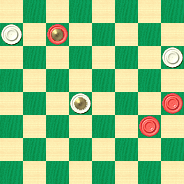The Checker Maven
Jump to navigationA Textbook Win

"Hitting the books" is something we were admonished to do throughout our academic years, from grade school all the way through graduate school. There was certainly a lot of knowledge in those weighty textbooks, and though acquiring that knowledge wasn't always an enjoyable experience, hitting the books usually paid off.
The same is true with checkers, although we have to admit to enjoying checker study a little more than we enjoyed things like tensor analysis or the works of Kant in the original German. Besides, if we want to be good at checkers, book learning is a necessity, not an option.
Today's study definitely could have come from a checker text.

BLACK
Black to Play and Win
B:W28,21,K15:BK27,13,9.
White has just played the losing 19-15. What should White have played? And more importantly, how can Black win? This problem is another example of the beautiful subtlety of checkers.
It's only fair to warn you that it will take Black a little while to win this. But the process is no more than a logical and methodical application of textbook principles.
Write a chapter in your own checker textbook by solving this problem, then click on Read More to see our own annotated solution.![]()
Solution
The Black win indeed takes many moves, but the principles are straightforward enough. Black holds the two White men on 28 and 21 while crowning his own man. Then Black drives the White king out of the double corner and, maintaining the "move", threatens to trap the White king. A judicious exchange at the very end seals the victory. It's not nearly as complex as it sounds, and the technique is one that will net many a point over the board.
| 36. | 27-23 | 15-10 |
White can't play 28-14 because of 23-19.
| 37. | 23-19 |
This is the key move. The man on 28 is held again, and White can't escape with 10-14.
| 37. | ... | 10-6 | |
| 38. | 9-14 |
Black can now go for a king at his leisure.
| 38. | ... | 6-9 | |
| 39. | 14-18 | 9-14 | |
| 40. | 18-22 |
14-17 is no better, and 21-17 loses at once to 22-25.
| 40. | ... | 14-10 | |
| 41. | 22-25 | 10-14 | |
| 42. | 25-30 | 14-18 | |
| 43. | 30-25 |
Black now drives the White king back.
| 43. | ... | 18-14 | |
| 44. | 25-22 | 14-9 | |
| 45. | 22-18 | 9-5 | |
| 46. | 18-14 | 5-1 |
Black can now advance his remaining man.
| 47. | 13-17 | 1-5 | |
| 48. | 17-22 | 5-1 | |
| 49. | 22-25 | 1-6 | |
| 50. | 25-30 | 6-1 | |
| 51. | 30-26 | 1-6 | |
| 52. | 26-23 | 6-1 | |
| 53. | 23-18 | 1-5 | |
| 54. | 18-15 | 5-1 | |
| 55. | 14-10 | ||
Entering the next phase.
| 55. | ... | 1-5 |
21-17 10-6 1-10 15-6 17-13 etc. and White still loses.
| 56. | 10-6 | 5-1 | |
| 57. | 15-10 | 1-5 | |
| 58. | 6-1 | 5-9 |
White leaves the double corner.
| 59. | 1-5 | 9-13 | |
| 60. | 10-6 | 13-17 | |
| 61. | 5-9 | 17-22 | |
| 62. | 9-14 | 22-25 | |
| 63. | 6-9 | 25-22 | |
| 64. | 9-13 | 22-25 | |
| 65. | 14-18 | 25-30 | |
| 66. | 18-22 | 21-17 | |
| 67. | 22-25! | 30x21 | |
| 68. | 13x22 |
Black wins. It was all very much "by the book."
Going all the way back to our original question, what should White have played instead of 19-15? The move to draw is 19-16. Can you see why? It's because then the White king can go to 20, allowing the man on 24 to advance. But after 19-15 27-23, the White king is cut off and the man on 24 can't go forward.
This very practical study is based on an actual game played recently at an on-line site.
You can email the Webmaster with comments on this article.
